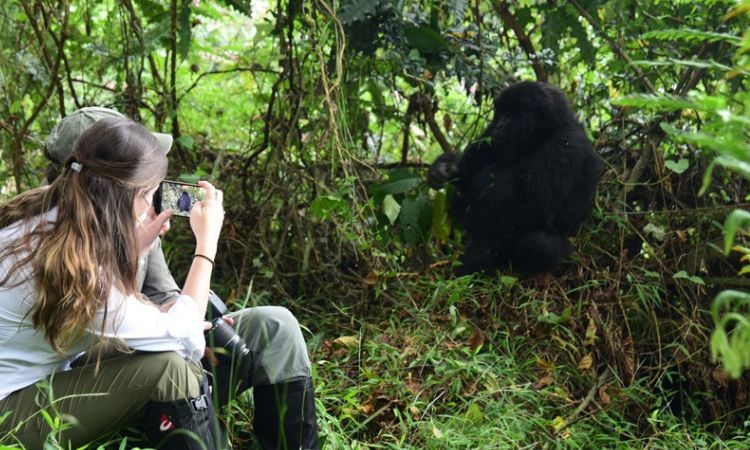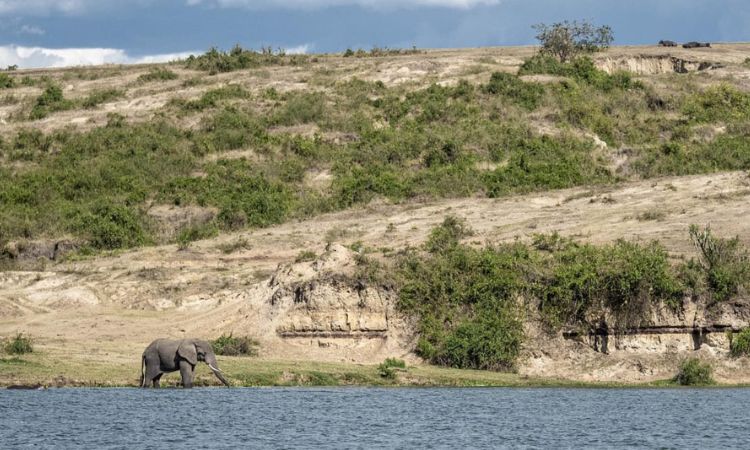Can Gorillas Bond with Humans: An Intriguing Insight 2025
Can gorillas bond with humans: Discover how gorillas form bonds with humans through years of habituation, intelligence, and conservation efforts in Uganda and Rwanda.
Many travelers who encounter gorillas in Uganda or Rwanda often wonder—can these powerful giants truly bond with humans? The answer lies in understanding their intelligence, emotions, and the remarkable habituation process that connects them to people.
From the misty slopes of Bwindi Impenetrable National Park in Uganda to the volcanic ridges of Volcanoes National Park in Rwanda, gorilla trekking reveals a world where human and gorilla relationships can flourish under careful conservation.
At All Uganda Safaris, we specialize in crafting unforgettable gorilla trekking experiences that highlight these profound connections while prioritizing safety and sustainability.
Gorilla Emotions and Intelligence: A Shared Heritage
Gorillas share approximately 98% of their DNA with humans, making them one of our closest living relatives. This genetic proximity translates into sophisticated emotional and cognitive abilities.
Mountain gorillas, the subspecies most commonly encountered on safaris in Uganda and Rwanda, display a wide range of emotions including affection, fear, grief, and empathy.
They form strong family bonds within troops led by a dominant silverback, and they recognize individual faces—both of other gorillas and, remarkably, familiar humans.
Do gorillas recognize humans? Yes, especially those they interact with regularly. Long-term studies show that gorillas can distinguish between different people, remembering caretakers, researchers, or guides from years prior.
This facial recognition underscores their intelligence, comparable to that of a human toddler in some social contexts. Gorillas communicate through vocalizations, body language, and even gentle touches, expressing curiosity or contentment toward trusted individuals.
Examples abound of gorillas showing affection. In habituated families, young gorillas may playfully approach guides, while adults offer reassuring grunts.
Are gorillas friendly to humans? In controlled settings with habituated groups, they often are—displaying curiosity rather than hostility.
Are silverback gorillas friendly to humans? The towering males, with their imposing size and strength, are protective leaders but can be remarkably gentle with familiar visitors, tolerating proximity during gorilla trekking in Uganda without aggression.
The Gorilla Habituation Process: Building Trust Step by Step
The foundation of any human and gorilla relationship is the gorilla habituation process—a meticulous, years-long effort to acclimate wild gorillas to human presence.
In parks like Bwindi Impenetrable Forest and Mgahinga Gorilla National Park in Uganda, or Virunga National Park in Congo, rangers and researchers begin by observing troops from a distance, gradually closing the gap over 2–3 years.
Gorilla habituation in Uganda involves daily visits where teams mimic non-threatening behaviors, such as knuckle-walking or chewing vegetation, to signal peace. Once habituated, these gorilla families become accessible for gorilla trekking experiences, allowing tourists to observe them from about 7 meters away.
Habituated gorilla families, like the Rushegura or Mubare groups in Bwindi, demonstrate how trust builds: gorillas go about their daily routines—feeding, grooming, playing—undisturbed by human observers.
This process not only enables safe gorilla trekking but also fosters bonds. Guides who accompany the same family repeatedly are often “recognized” with calm acknowledgment, proving that do gorillas like humans? In habituated contexts, many do, viewing them as part of the landscape rather than threats.

Famous Examples of Human-Gorilla Bonds
History is rich with stories illustrating how deep these connections can run. Dian Fossey, the pioneering primatologist, spent over a decade in Rwanda’s Volcanoes National Park studying mountain gorillas.
Her work with groups like the one led by silverback Digit showed mutual trust; gorillas allowed her close enough to touch, and she documented their emotional lives in her book Gorillas in the Mist. Fossey’s legacy continues through the Dian Fossey Gorilla Fund, protecting these primates today.
Another iconic case is Koko the gorilla, a western lowland gorilla raised in captivity who learned over 1,000 signs in American Sign Language. Koko expressed complex emotions, forming a profound bond with her trainer, Penny Patterson.
She mourned the death of her kitten companion and even “introduced” herself to actor Robin Williams, showing joy and recognition. While Koko was not wild, her story highlights gorillas’ capacity for interspecies empathy.
In the wild, modern examples emerge from gorilla conservation in Uganda. Rangers in Bwindi report silverbacks positioning themselves protectively between their family and strangers, yet relaxing around known guides.
Do gorillas protect humans? In rare instances, yes—habituated silverbacks have been observed intervening in potential conflicts, treating familiar humans almost as extended troop members.
Can Gorillas Be Dangerous to Humans? Balancing Affection and Wild Instincts
While heartwarming bonds exist, gorillas remain wild animals. Are gorillas friendly or aggressive? It depends on context. Habituated gorillas are generally calm, but provocation—such as direct eye contact, sudden movements, or invading space—can trigger a charge.
Silverbacks, weighing up to 200 kg, use bluff charges (beating chests, roaring) to intimidate rather than attack, but injuries can occur.
Safety during gorilla trekking is paramount. All Uganda Safaris ensures clients follow Uganda Wildlife Authority guidelines: maintain 7–10 meters distance, no flash photography, and retreat if a gorilla approaches.
How close can you get to a gorilla? Regulations allow 7 meters, but curious juveniles may close the gap—guides manage this expertly.
Can you hug a gorilla? Absolutely not. Touching is prohibited to prevent disease transmission (gorillas are susceptible to human illnesses like colds) and to respect their wild nature.
What happens if a gorilla charges? Stay calm, crouch low, avoid eye contact, and let guides handle it—most charges end without contact.

Conservation and Responsible Tourism: Sustaining the Bond
Positive human-gorilla relationships thrive through conservation. Gorilla tourism funds protection: in Uganda, revenue from permits (around $800 for trekking, $1,500 for habituation experiences) supports anti-poaching and community projects.
Responsible tourism in Rwanda and protecting mountain gorillas via organizations like WWF ensure populations grow—from about 1,000 mountain gorillas today, up from endangered lows.
All Uganda Safaris promotes ethical practices: small groups, licensed guides, and contributions to local communities. This sustains gorilla conservation in Uganda while allowing travelers to witness bonds firsthand.
Where to See Gorillas in the Wild
The best places to see gorillas include:
- Bwindi Impenetrable National Park (Uganda): Home to half the world’s mountain gorillas, with multiple habituated families for trekking.
- Mgahinga Gorilla National Park (Uganda): Smaller but stunning, with the Nyakagezi group.
- Volcanoes National Park (Rwanda): Iconic for Fossey’s work, offering premium trekking.
- Virunga National Park (Congo): Adventurous option with diverse landscapes.
Gorilla trekking in Uganda stands out for affordability and variety—book with All Uganda Safaris for seamless experiences.
Traveler Tips and FAQs
How close can you get to a gorilla?
Minimum 7 meters; closer if they approach (under guide supervision).
Can I touch a gorilla?
No—risks health and safety for both.
What happens if a gorilla charges?
Crouch, avert eyes, remain still; it’s usually a bluff.
Can gorillas recognize their guides?
Yes, habituated ones often do, showing relaxed behavior.
Are gorillas friendly to humans?
Habituated ones yes; wild ones avoid or defend.
Are silverback gorillas friendly to humans?
Protective but tolerant of familiar people.
Do gorillas protect humans?
Rarely, but trusted individuals may benefit from their vigilance.
Can you hug a gorilla?
Never—it’s unsafe and illegal.
Conclusion: A Bond Worth Protecting
Can gorillas be friendly to humans? Through intelligence, habituation, and conservation, yes—they form trusting relationships that enrich our understanding of the natural world. On a gorilla trekking experience with All Uganda Safaris in Bwindi or beyond, you’ll witness this magic.
Book your Uganda Gorilla safari today and discover the human and gorilla relationship in its purest form.



